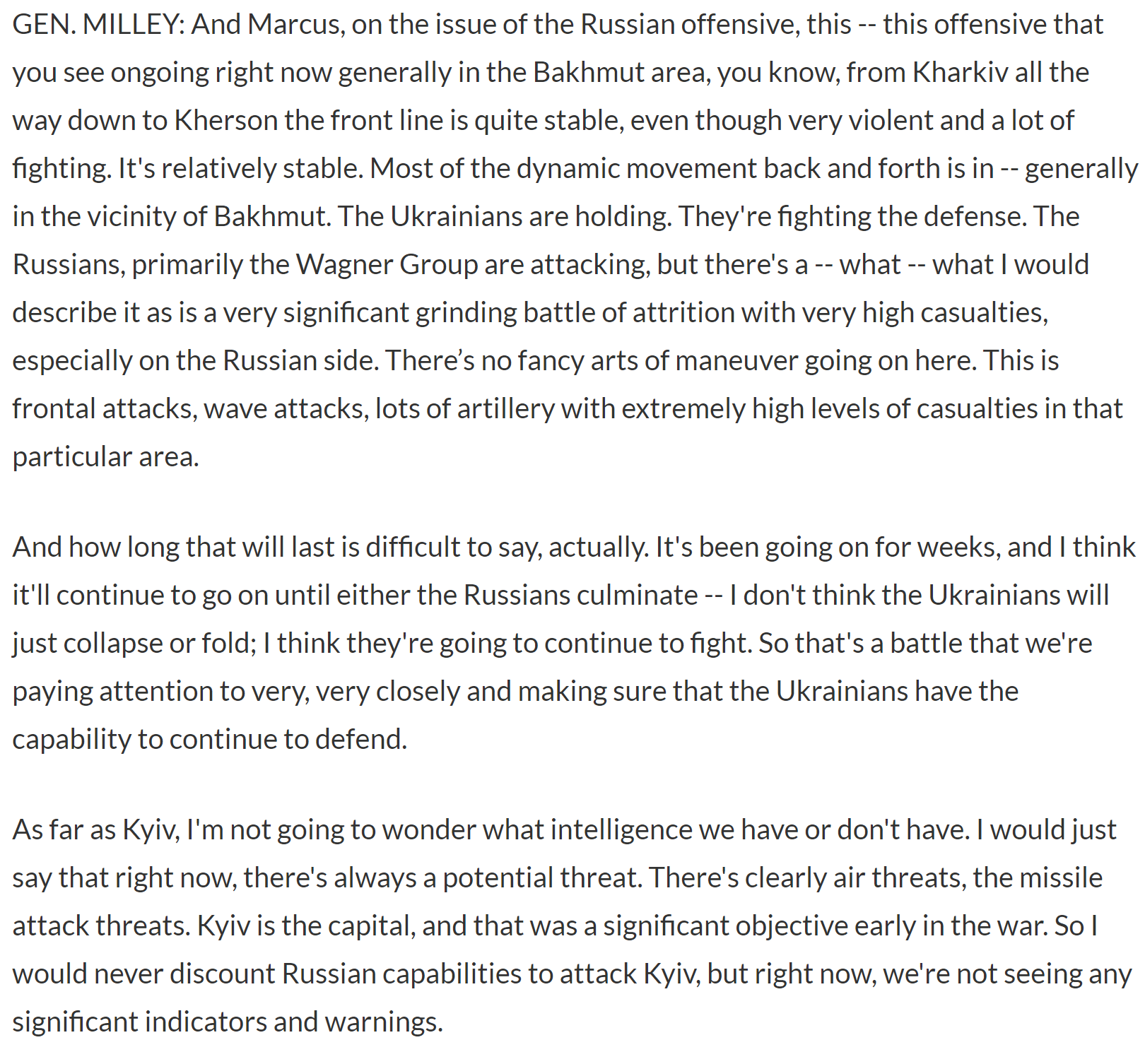Thread by Michael Kofman
Thread
A few thoughts on the Russian winter offensive, which began 3+ weeks ago, and has so far yielded little progress for RU forces. Poor force quality, loss of junior officers, ammunition, and equipment constraints limit Russian offensive potential. Thread. 1/
The RU offensive consists of about 5-6 axes of attack focused on the Donbas. Rather than a major push along one part of the front, it is instead a series of distributed battles running north-south from Luhansk, to Bakhmut, and southern Donetsk. 2/
Russian forces are attacking at Vuhledar, Marinka, Adviivka, Bakhmut (and Bilohorivka), Kreminna -> Lyman, with attempts to advance near Kupyansk. The offensive began in the last week of January with a Russian assault on Vuhledar. 3/
The battle for Vuhledar involves two NI brigades (155th, 40th), and has not gone well for the Russian military. RU units refilled with mobilized personnel seem to have lost a fair bit of their offensive edge, but I’m not sure this is a ‘failure to learn.’ 4/
The terrain outside of Vuhledar is very open, heavily mined, and covered by UA ATGM teams. It leaves RU forces few options for an assault. I also wonder if the Russian military may be short on specialized equipment for tasks like mine clearing. 5/
At Kreminna RU VDV seems to have made some incremental gains against UA positions. Depending on how that battle plays out it may force UA to abandon the Kreminna campaign or lead to see-saw battles in the forest west of the city. 6/
There’s a growing likelihood that UA will withdraw from Bakhmut to another defensive line east of Slovyansk/Kramatorsk. The Russian military may then turn north and try to consolidate control up to the Donets river (including Bilohorivka). 7/
RU forces have not had much success at Avdiivka or Marinka. This is another area that’s seen months of fighting. The Russian offensive doesn’t look like much of an offensive because it is playing out in areas that have previously seen unsuccessful Russian attacks. 8/
At this stage it doesn’t seem that RU has employed reserves, and is likely using those units to replace casualties, or perhaps waiting for a breakthrough to exploit. That said, there’s not much evidence of a larger additional RU force in the waiting. 9/
I’ve been skeptical that there is an additional ‘spring offensive’ looming. To conduct such an operation RU would likely need a second mobilization wave, in advance, which never took place. Predictions that 500k troops would be mobilized mid-January proved incorrect. 10/
Senior US and NATO military officials have begun saying much the same in recent days. There’s a relative consensus that the Russian offensive to take the Donbas began some time ago, and its going about as expected given the state of the force. 11/ www.defense.gov/News/Transcripts/Transcript/Article/3298235/secretary-of-defense-lloyd-j-austin-iii-a...
My best guess is Moscow will wait to see what comes of this offensive before proceeding with a second mobilization wave. I would not discount anything, but right now the RU offensive looks to yield mostly incremental gains that come at the expense of equipment and ammunition. 12/
One possibility is that after UA launches an offensive in the spring, RU will then choose to mobilize in the summer, an attempt another operation later. Given UA no longer enjoys a manpower advantage, RU strategy in 2023 could be to grind away at UA manpower. 13/
Russian forces are expending artillery ammunition in this offensive which they will miss in the spring. The coming months will reveal the real situation in RU artillery ammo availability, which I expect is quite problematic, forcing them to ration. 14/
That said, Ukrainian forces may also have issues with artillery ammo and barrels. This remains a near to medium term challenge. Rosy assessments of Western ammo production potential over the long-term might not align well with UA requirements for the coming 6-12 months. 15/
UA is better served absorbing the RU attack & exhausting RU offensive potential, then taking the initiative later this spring. Having expended ammunition, better troops, and equipment it could leave RU defense overall weaker. 16/
My impression is that Surovkin, who stabilized RU lines, preferred a defensive strategy, rebuilding the force, and preferring to defend against a Ukrainian offensive in the south. Then have RU forces launch an offensive later in the summer to try and capture the Donbas. 17/
Instead, Gerasimov is exhausting the Russian armed forces with a feckless series of offensive operations, which may yield some gains, like Bakhmut, but unlikely to change the strategic picture. The second battle for the Donbas may once again leave RU forces vulnerable. 18/
A spring offensive will still prove a difficult operation for UA. Russian mil now has enough manpower & reserves to avoid a depleted frontline as in Kharkiv. Kherson is an imperfect, but probably a better guide for how a future UA offensive may unfold. 19/
Whether Western AFVs make much of a difference depends on employment and the timing of the UA offensive. Its possible, if UA waits for the force to absorb it in quantity, but I suspect this equipment will mostly serve to backfill losses from the next operation. 20/
For a bit more on this I would suggest tuning into this WOTR podcast from yesterday. We talk about the Russian offensive, key battles to watch, and how it could shape Ukraine’s plans for the spring. warontherocks.com/2023/02/russias-winter-offensive/
